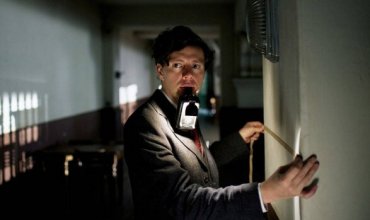THE THIRD MAN is a thriller made in 1949. The film is the best known example of British noir. It doesn’t deal with crime in any of the expected ways. Instead, it is set and shot in post-war Vienna and carries with it the impact of being based in the reality of the time. It doesn’t have the documentary feel of Rossellini’s ROME, OPEN CITY made at the very end of the war, yet the premise and the immediacy of the movie is unusual for British cinema of the era. The gleaming black and white images shot by cinematographer Robert Krasker reveal a shattered city with areas still bombed into rubble.
The story begins with the arrival of American author Holly Martins (Joseph Cotten) into Vienna. He is broke and has been invited to take a job there by his old school friend, the as yet unseen, Harry Lime (Orson Welles). We learn two things quickly. First, Vienna is a divided city run by a quartet of military powers, including the British. Second, Harry Lime has been killed in a truck accident. In short order Martins meets the head of the British force, Calloway (Trevor Howard) and Lime’s girlfriend an actress called Anna Schmidt (Alida Valli). Martins learns that Lime is supposed by the authorities to be a criminal and his death was the natural result of the life he led. Anna doesn’t believe in this picture of Lime. Martins decides to remain in Vienna and works to clear Harry’s name. He tracks down a number of Harry’s friends and learns about the circumstances of the accident. It appears that he was killed almost instantly and his body was carried from the road to the footpath, by two men or possibly three. However Martins can find no one who can confirm the existence of the third man.
The movie was a hit, helped in no small part by the unusual choice to use the zither music of Anton Karas rather than a more conventional orchestral score. The zither playing (invariably described as “jaunty”) pulls off the neat trick of undercutting the noirness and yet gives the story a jittery, off-kilter energy. If you haven’t heard the Harry Lime theme before, be prepared for a 48-hour ear worm.
The story was penned by author Graham Greene, who visualised the whole thing as a novella first, before adapting the work to a screenplay. Director Carol Reed does some of his finest work here. The performances are all first rate. Trevor Howard was never better. His crisp, no-nonsense Calloway has a degree of empathy lacking in his many other hard man roles. Cotten plays Martins as game-for-anything, romantic and determinedly clueless. Alida Valli gives solidity to what could have been an underwritten “mysterious woman” part. Orson Welles in his short screen time, delivers a punch by playing a friendly, apparently civilised man with no moral centre. He’s like a more lethal version of Jay Gatsby.
THE THIRD MAN is a fine film with all contributors at the top of their form. It is an entertaining movie, indeed Greene would doubtless have placed the novella in the category of one his “entertainments” to distinguish it from his more literary works. Sixty-five-years on and it will reward those who enjoy the storytelling of the era and insistent zither music.
NOTE: This review was written specifically for a 2017 event in which a digital 4K version of THE THIRD MAN was screened at the Windsor Cinema in Nedlands as part of David Stratton’s Great Britain Retro Film Fest. The film’s cinematographer Robert Krasker was raised here in Western Australia. When he won an Oscar for his work on THE THIRD MAN, he became the first Australian cinematographer to do so.


